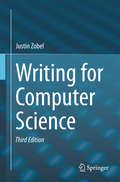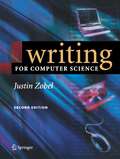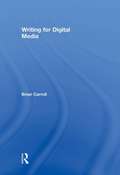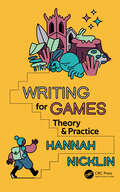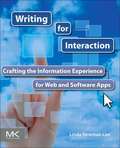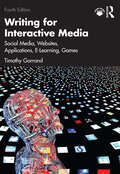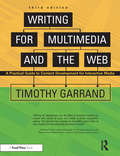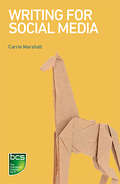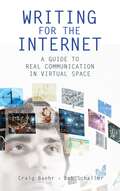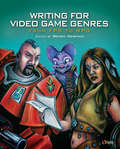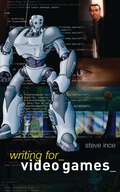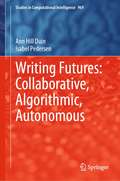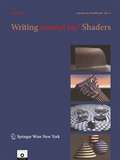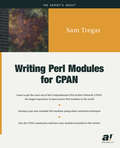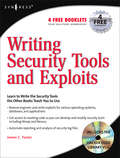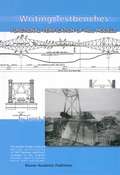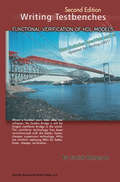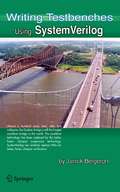- Table View
- List View
Writing for Computer Science
by Justin ZobelAll researchers need to write or speak about their work, and to have research that is worth presenting. Based on the author's decades of experience as a researcher and advisor, this third edition provides detailed guidance on writing and presentations and a comprehensive introduction to research methods, the how-to of being a successful scientist. Topics include:· Development of ideas into research questions;· How to find, read, evaluate and referee other research;· Design and evaluation of experiments and appropriate use of statistics;· Ethics, the principles of science and examples of science gone wrong.Much of the book is a step-by-step guide to effective communication, with advice on: · Writing style and editing;· Figures, graphs and tables;· Mathematics and algorithms;· Literature reviews and referees’ reports;· Structuring of arguments and results into papers and theses;· Writing of other professional documents;· Presentation of talks and posters.Written in an accessible style and including handy checklists and exercises, Writing for Computer Science is not only an introduction to the doing and describing of research, but is a valuable reference for working scientists in the computing and mathematical sciences.
Writing for Computer Science
by Justin ZobelA complete update to a classic, respected resource Invaluable reference, supplying a comprehensive overview on how to undertake and present research
Writing for Digital Media
by Brian CarrollThis work teaches students how to write effectively for online audiences while providing them with a solid understanding of the ways that the Internet has blurred traditional roles of media producer, consumer, publisher, and reader. 9780415992015 9780203894316
Writing for Digital Media (PDF)
by Brian CarrollThis work teaches students how to write effectively for online audiences while providing them with a solid understanding of the ways that the Internet has blurred traditional roles of media producer, consumer, publisher, and reader. 9780415992015 9780203894316
Writing for Games: Theory and Practice
by Hannah NicklinFocussing on the independent videogames sector, this book provides readers with a vocabulary to articulate and build their games writing practice; whether studying games or coming to games from another storytelling discipline. Writing for Games offers resources for communication, collaboration, reflection, and advocacy, inviting the reader to situate their practice in a centuries-long heritage of storytelling, as well as considering the material affordances of videogames, and the practical realities of working in game development processes. Structured into three parts, Theory considers the craft of both games and writing from a theoretical perspective, covering vocabulary for both game and story practices. Case Studies uses three case studies to explore the theory explored in Part 1. The Practical Workbook offers a series of provocations, tools and exercises that give the reader the means to refine and develop their writing, not just for now, but as a part of a life-long practice. Writing for Games: Theory and Practice is an approachable and entry-level text for anyone interested in the craft of writing for videogames. Hannah Nicklin is an award-winning narrative and game designer, writer, and academic who has been practising for nearly 15 years. She works hard to create playful experiences that see people and make people feel seen, and also argues for making games a more radical space through mentoring, advocacy, and redefining process. Trained as a playwright, Nicklin moved into interactive practices early on in her career and is now the CEO and studio lead at Danish indie studio Die Gute Fabrik, which most recently launched Mutazione in 2019.
Writing for Games: Theory and Practice
by Hannah NicklinFocussing on the independent videogames sector, this book provides readers with a vocabulary to articulate and build their games writing practice; whether studying games or coming to games from another storytelling discipline. Writing for Games offers resources for communication, collaboration, reflection, and advocacy, inviting the reader to situate their practice in a centuries-long heritage of storytelling, as well as considering the material affordances of videogames, and the practical realities of working in game development processes. Structured into three parts, Theory considers the craft of both games and writing from a theoretical perspective, covering vocabulary for both game and story practices. Case Studies uses three case studies to explore the theory explored in Part 1. The Practical Workbook offers a series of provocations, tools and exercises that give the reader the means to refine and develop their writing, not just for now, but as a part of a life-long practice. Writing for Games: Theory and Practice is an approachable and entry-level text for anyone interested in the craft of writing for videogames. Hannah Nicklin is an award-winning narrative and game designer, writer, and academic who has been practising for nearly 15 years. She works hard to create playful experiences that see people and make people feel seen, and also argues for making games a more radical space through mentoring, advocacy, and redefining process. Trained as a playwright, Nicklin moved into interactive practices early on in her career and is now the CEO and studio lead at Danish indie studio Die Gute Fabrik, which most recently launched Mutazione in 2019.
Writing for Interaction: Crafting the Information Experience for Web and Software Apps
by Linda Newman LiorWriting for Interaction focuses on the art of creating the information experience as it appears within software and web applications, specifically in the form of user interface text. It also provides strategies for ensuring a consistent, positive information experience across a variety of delivery mechanisms, such as online help and social media. Throughout this book, you'll learn simple techniques for writing consistent text with the right tone, how to select content delivery mechanisms, and how straightforward, clear layouts help your customer interact with your application. Divided into five sections, the book completely covers the information experience design process from beginning to end. You'll cover everything from understanding your users and their needs, to creating personas, designing the IX strategy, creating your information, and evaluating the resulting information experience. This is your one-stop reference for information experience!Illuminates writing principles and practices for use in interactive design Includes examples, checklists, and sample processes, highlighting practical approaches to designing the information experience Provides the complete picture: understanding customer needs, creating personas, and writing the text appearing within the user interface
Writing for Interactive Media: Social Media, Websites, Applications, e-Learning, Games
by Timothy GarrandThis thoroughly revised fourth edition teaches students and professionals how to create interactive content for all types of new media and become successful writers or designers in a variety of fields.This comprehensive guide is grounded in the core principles and skills of interactive media writing, in which writers create text and structure content to guide users through interactive products such as websites or software. The book examines case studies on interactive formats including complex informational websites, computer games, e-learning courses, training programs, and immersive exhibits. These case studies assess real-world products and documentation used by professional writers such as scripts, outlines, screenshots, and flowcharts. The book also provides practical advice on how to use interactive media writing skills to advance careers in the social media, technical, instructional communication, and creative media fields. This edition includes new chapters on UX Writing and Content Design, Social Media Writing, and Writing for Mobile.Writing for Interactive Media prepares students for the writing challenges of today’s technology and media. It can be used as a core textbook for courses in UX Writing, Writing for Digital Media, and Technical and Professional Communication and is a valuable resource for writing professionals at all levels.Supplemental resources include a sample syllabus, class assignments, student exercises, scripts, outlines, flowcharts, and other interactive writing samples. They are available online at www.routledge.com/9781032554242
Writing for Interactive Media: Social Media, Websites, Applications, e-Learning, Games
by Timothy GarrandThis thoroughly revised fourth edition teaches students and professionals how to create interactive content for all types of new media and become successful writers or designers in a variety of fields.This comprehensive guide is grounded in the core principles and skills of interactive media writing, in which writers create text and structure content to guide users through interactive products such as websites or software. The book examines case studies on interactive formats including complex informational websites, computer games, e-learning courses, training programs, and immersive exhibits. These case studies assess real-world products and documentation used by professional writers such as scripts, outlines, screenshots, and flowcharts. The book also provides practical advice on how to use interactive media writing skills to advance careers in the social media, technical, instructional communication, and creative media fields. This edition includes new chapters on UX Writing and Content Design, Social Media Writing, and Writing for Mobile.Writing for Interactive Media prepares students for the writing challenges of today’s technology and media. It can be used as a core textbook for courses in UX Writing, Writing for Digital Media, and Technical and Professional Communication and is a valuable resource for writing professionals at all levels.Supplemental resources include a sample syllabus, class assignments, student exercises, scripts, outlines, flowcharts, and other interactive writing samples. They are available online at www.routledge.com/9781032554242
Writing for Multimedia and the Web: A Practical Guide to Content Development for Interactive Media
by Timothy GarrandLearning how to write for just one type of interactive media, such as web sites or games, is not enough! To be truly successful as an interactive writer or designer, you need to understand how to create content for all types of new media.Writing for Multimedia and the Web is the most comprehensive guide available for interactive writing. It covers web sites, computer games, e-learning courses, training programs, immersive exhibits, and much more. Earlier editions have garnered rave reviews as a writing handbook for multimedia and web professionals, as well as a classroom text for interactive writing and design.New Sections and Completely Updated Chapters:*Writing a corporate web site: T. Rowe Price*Creating blogs and podcasts*Web writing tips from usability experts*Optimizing text for web search engines*Defining the user with use cases and user scenarios*Dealing with web editors*Software for organizing and writing interactive media content*Script formats for all types of multimedia and web projects*Writing careers
Writing for Multimedia and the Web: A Practical Guide to Content Development for Interactive Media
by Timothy GarrandLearning how to write for just one type of interactive media, such as web sites or games, is not enough! To be truly successful as an interactive writer or designer, you need to understand how to create content for all types of new media.Writing for Multimedia and the Web is the most comprehensive guide available for interactive writing. It covers web sites, computer games, e-learning courses, training programs, immersive exhibits, and much more. Earlier editions have garnered rave reviews as a writing handbook for multimedia and web professionals, as well as a classroom text for interactive writing and design.New Sections and Completely Updated Chapters:*Writing a corporate web site: T. Rowe Price*Creating blogs and podcasts*Web writing tips from usability experts*Optimizing text for web search engines*Defining the user with use cases and user scenarios*Dealing with web editors*Software for organizing and writing interactive media content*Script formats for all types of multimedia and web projects*Writing careers
Writing for Social Media
by Carrie MarshallEngaging with customers through social media is essential for businesses in this day and age. Writing for social media can be difficult to get right and even big brands can get it very wrong. This book walks you through how to deliver maximum benefit for your business through your social media writing. Topics include how to develop an online persona, how to tailor your messages across different social media platforms, how to appeal to your audience, and how to use social media tools.
Writing for Social Media: Business And Technical Writing Series
by Carrie MarshallEngaging with customers through social media is essential for businesses in this day and age. Writing for social media can be difficult to get right and even big brands can get it very wrong. This book walks you through how to deliver maximum benefit for your business through your social media writing. Topics include how to develop an online persona, how to tailor your messages across different social media platforms, how to appeal to your audience, and how to use social media tools.
Writing for the Internet: A Guide to Real Communication in Virtual Space (Non-ser.)
by Craig Baehr Robert C. Jr.This book is a landmark guide full of practical examples and sound advice for communicating online concisely and effectively.Intended for students—and everyone else who writes for online media—Writing for the Internet: A Guide to Real Communication in Virtual Space is a landmark collection of grounded and practical applications about writing effectively and concisely. It covers just about everything one needs to know about a broad array of topics including online publishing, new media news writing, blogging, micro-blogging, Internet writing technologies, and social media/ownership. At the same time, it addresses theories, methods, and practices used by Internet writers and online journalists from a wide range of backgrounds.The book introduces students who will be writing online—and this includes all disciplines of every possible major—to the basic tenets of good online writing habits and principles. It will help bloggers hone their thoughts and express them in writing that works in real-time media. And it will help those who wish to take advantage of the extraordinary profit-making potential the Internet represents.
Writing for Video Game Genres: From FPS to RPG
by Wendy DespainThis book, written and edited by members of the International Game Developers Association (IGDA) Game Writing Special Interest Group, follows the acclaimed Professional Techniques for Video Game Writing to deliver practical advice from seasoned veterans on the special challenges of writing for first-person shooter games (FPS), role-playing games (R
Writing for Video Games (Professional Media Practice)
by Steve InceVideo games is a lucrative new market for scriptwriters but writing for video games is complex and very different to traditional media (tv or film). This practical guide shows how you can adapt your writing skills to this exciting medium. Written by an award-winning games writer, the book gives you a realistic picture of how games companies work, how the writer fits into the development process, and the skills required: from storytelling, to developing interactive narrative, characters and viewpoints, dialogue comedy and professional practice. Illustrated with examples from games and quotes from developers, writers and agents, this is a cutting edge professional writing guide at a very accessible price.
Writing Futures: Collaborative, Algorithmic, Autonomous (Studies in Computational Intelligence #969)
by Ann Hill Duin Isabel PedersenThis book is useful to understand and write alongside non-human agents, examine the impact of algorithms and AI on writing, and accommodate relationships with autonomous agents. This ground-breaking future-driven framework prepares scholars and practitioners to investigate and plan for the social, digital literacy, and civic implications arising from emerging technologies. This book prepares researchers, students, practitioners, and citizens to work with AI writers, virtual humans, and social robots. This book explores prompts to envision how fields and professions will change. The book’s unique integration with Fabric of Digital Life, a database and structured content repository for conducting social and cultural analysis of emerging technologies, provides concrete examples throughout. Readers gain imperative direction for collaborative, algorithmic, and autonomous writing futures.
Writing In-House Medical Device Software in Compliance with EU, UK, and US Regulations
by Philip S. Cosgriff Matthew J. MemmottThis book is a comprehensive guide to producing medical software for routine clinical use. It is a practical guidebook for medical professionals developing software to ensure compliance with medical device regulations for software products intended to be sold commercially, shared with healthcare colleagues in other hospitals, or simply used in-house.It compares requirements and latest regulations in different global territories, including the most recent EU regulations as well as UK and US regulations.This book is a valuable resource for practising clinical scientists producing medical software in-house, in addition to other medical staff writing small apps for clinical use, clinical scientist trainees, and software engineers considering a move into healthcare. The academic level is post-graduate, as readers will require a basic knowledge of software engineering principles and practice.Key Features: Up to date with the latest regulations in the UK, the EU, and the US Useful for those producing medical software for routine clinical use Contains best practice
Writing In-House Medical Device Software in Compliance with EU, UK, and US Regulations
by Philip S. Cosgriff Matthew J. MemmottThis book is a comprehensive guide to producing medical software for routine clinical use. It is a practical guidebook for medical professionals developing software to ensure compliance with medical device regulations for software products intended to be sold commercially, shared with healthcare colleagues in other hospitals, or simply used in-house.It compares requirements and latest regulations in different global territories, including the most recent EU regulations as well as UK and US regulations.This book is a valuable resource for practising clinical scientists producing medical software in-house, in addition to other medical staff writing small apps for clinical use, clinical scientist trainees, and software engineers considering a move into healthcare. The academic level is post-graduate, as readers will require a basic knowledge of software engineering principles and practice.Key Features: Up to date with the latest regulations in the UK, the EU, and the US Useful for those producing medical software for routine clinical use Contains best practice
Writing mental ray® Shaders: A Perceptual Introduction (mental ray® Handbooks #3)
by Andy KopraAn increasing number of artists and programmers in visual effects and broadcast production now use mental ray, a high performance rendering engine for generating photorealistic images. This book details the aesthetics of rendering with mental ray. It describes the varieties of shader programming from the point of view of increasing perceptual complexity: from color to the output of the final image. It includes many example shaders, including the simplest shader possible in each category that can serve as a starting point for further customization.
Writing Perl Modules for CPAN
by Sam TregarThe author Sam Tregar tells programmers how best to use and contribute modules to the Open Source repository known as CPAN (Comprehensive Perl Archive Network).
Writing Security Tools and Exploits
by James C FosterWriting Security Tools and Exploits will be the foremost authority on vulnerability and security code and will serve as the premier educational reference for security professionals and software developers. The book will have over 600 pages of dedicated exploit, vulnerability, and tool code with corresponding instruction. Unlike other security and programming books that dedicate hundreds of pages to architecture and theory based flaws and exploits, this book will dive right into deep code analysis. Previously undisclosed security research in combination with superior programming techniques will be included in both the Local and Remote Code sections of the book. The book will be accompanied with a companion Web site containing both commented and uncommented versions of the source code examples presented throughout the book. In addition to the book source code, the CD will also contain a copy of the author-developed Hacker Code Library v1.0. The Hacker Code Library will include multiple attack classes and functions that can be utilized to quickly create security programs and scripts. These classes and functions will simplify exploit and vulnerability tool development to an extent never before possible with publicly available software.* Provides readers with working code to develop and modify the most common security tools including Nmap and Nessus* Learn to reverse engineer and write exploits for various operating systems, databases, and applications* Automate reporting and analysis of security log files
Writing Testbenches: Functional Verification of HDL Models
by Janick BergeronCHAPTER 6 Architecting Testbenches 221 Reusable Verification Components 221 Procedural Interface 225 Development Process 226 Verilog Implementation 227 Packaging Bus-Functional Models 228 Utility Packages 231 VHDL Implementation 237 Packaging Bus-Functional Procedures 238 240 Creating a Test Harness 243 Abstracting the Client/Server Protocol Managing Control Signals 246 Multiple Server Instances 247 Utility Packages 249 Autonomous Generation and Monitoring 250 Autonomous Stimulus 250 Random Stimulus 253 Injecting Errors 255 Autonomous Monitoring 255 258 Autonomous Error Detection Input and Output Paths 258 Programmable Testbenches 259 Configuration Files 260 Concurrent Simulations 261 Compile-Time Configuration 262 Verifying Configurable Designs 263 Configurable Testbenches 265 Top Level Generics and Parameters 266 Summary 268 CHAPTER 7 Simulation Management 269 Behavioral Models 269 Behavioral versus Synthesizable Models 270 Example of Behavioral Modeling 271 Characteristics of a Behavioral Model 273 x Writing Testbenches: Functional Verification of HDL Models Modeling Reset 276 Writing Good Behavioral Models 281 Behavioral Models Are Faster 285 The Cost of Behavioral Models 286 The Benefits of Behavioral Models 286 Demonstrating Equivalence 289 Pass or Fail? 289 Managing Simulations 292 294 Configuration Management Verilog Configuration Management 295 VHDL Configuration Management 301 SDF Back-Annotation 305 Output File Management 309 Regression 312 Running Regressions 313 Regression Management 314 Summary 316 APPENDIX A Coding Guidelines 317 Directory Structure 318 VHDL Specific 320 Verilog Specific 320 General Coding Guidelines 321 Comments 321 Layout 323 Syntax 326 Debugging 329 Naming Guidelines 329 Capitalization 330 Identifiers 332 Constants 334 334 HDL Specific Filenames 336 HDL Coding Guidelines 336 337 Structure 337 Layout
Writing Testbenches: Functional Verification of HDL Models
by Janick Bergeronmental improvements during the same period. What is clearly needed in verification techniques and technology is the equivalent of a synthesis productivity breakthrough. In the second edition of Writing Testbenches, Bergeron raises the verification level of abstraction by introducing coverage-driven constrained-random transaction-level self-checking testbenches all made possible through the introduction of hardware verification languages (HVLs), such as e from Verisity and OpenVera from Synopsys. The state-of-art methodologies described in Writing Test benches will contribute greatly to the much-needed equivalent of a synthesis breakthrough in verification productivity. I not only highly recommend this book, but also I think it should be required reading by anyone involved in design and verification of today's ASIC, SoCs and systems. Harry Foster Chief Architect Verplex Systems, Inc. xviii Writing Testbenches: Functional Verification of HDL Models PREFACE If you survey hardware design groups, you will learn that between 60% and 80% of their effort is now dedicated to verification.
Writing Testbenches using SystemVerilog
by Janick BergeronVerification is too often approached in an ad hoc fashion. Visually inspecting simulation results is no longer feasible and the directed test-case methodology is reaching its limit. Moore's Law demands a productivity revolution in functional verification methodology. Writing Testbenches Using SystemVerilog offers a clear blueprint of a verification process that aims for first-time success using the SystemVerilog language. From simulators to source management tools, from specification to functional coverage, from I's and O's to high-level abstractions, from interfaces to bus-functional models, from transactions to self-checking testbenches, from directed testcases to constrained random generators, from behavioral models to regression suites, this book covers it all. Writing Testbenches Using SystemVerilog presents many of the functional verification features that were added to the Verilog language as part of SystemVerilog. Interfaces, virtual modports, classes, program blocks, clocking blocks and others SystemVerilog features are introduced within a coherent verification methodology and usage model. Writing Testbenches Using SystemVerilog introduces the reader to all elements of a modern, scalable verification methodology. It is an introduction and prelude to the verification methodology detailed in the Verification Methodology Manual for SystemVerilog. It is a SystemVerilog version of the author's bestselling book Writing Testbenches: Functional Verification of HDL Models.
